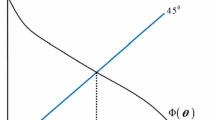Abstract
In the context of mixed markets, Matsumura and Kanda (J Econ 84(1): 27–48, 2005) show that social welfare in free entry equilibrium is maximized when there exists a public firm in the market. En passant, these authors state that this outcome is connected to the entry-deterring influence of a public firm. In this way, they counter-act the excess entry problem of Mankiw and Whinston (Rand J Econ 17(1): 48–58, 1986). We explain this result arguing that the state-owned firm can be an indirect instrument to regulate entry. In fact, under free entry equilibrium welfare may be greater with the presence of a public firm than with a social planner.
Similar content being viewed by others
References
Bradburd R (1995). Privatization of natural monopoly public enterprises – the regulation issue. Rev Ind Organ 10(3): 247–267
Cabral LMB (2004). Simultaneous entry and welfare. Eur Econ Rev 48: 943–957
Cremer H, Marchand M and Thisse JF (1989). The public firm as an instrument for regulating an oligopolistic market. Oxf Econ Pap 41: 283–301
De Fraja G and Delbono F (1989). Alternative strategies of a public enterprise in oligopoly. Oxf Econ Pap 41: 302–311
D’Souza J, Megginson W and Nash R (2005). Effect of institutional and firm-specific characteristics on post-privatization performance: Evidence from developed countries. J Corp Finance 11(5): 747–766
Garvie D and Ware R (1996). Public firms as regulatory instruments with cost uncertainty. Can J Econ 29(2): 357–378
Harris RG and Wiens E (1980). Government enterprise: an instrument for the internal regulation of industry. Can J Econ 13(1): 125–132
Kikeri S and Nellis J (2004). An assessment of privatization. World Bank Res Obs 19(1): 87–118
Mankiw NG and Whinston MD (1986). Free entry and social inefficiency. Rand J Econ 17(1): 48–58
Matsumura T and Kanda O (2005). Mixed oligopoly at free entry markets. J Econ 84(1): 27–48
Megginson WL and Netter JM (2001). From state to market: a survey of empirical studies on privatization. J Econ Lit 39: 321–389
Megginson WL and Sutter NL (2006). Privatisation in developing countries. Corp Gov Int Rev 14(4): 234–265
Okten C and Arin KP (2006). The effects of privatization on efficiency: how does privatization work. World Dev 34(9): 1537–1556
Shleifer A and Vishny R (1994). Politicians and firms. Q J Econ 109: 995–1025
Vickers J, Yarrow G (1988) Privatization: an economic analysis. MIT Press Series on the Regulation of Economic Activity, vol 18. MIT Press, Cambridge, MA
Willner J (1996). Privatisation of natural monopolies – comment. Rev Ind Organ 11(6): 869–882
Author information
Authors and Affiliations
Corresponding author
Rights and permissions
About this article
Cite this article
Brandão, A., Castro, S. State-owned enterprises as indirect instruments of entry regulation. J Econ 92, 263–274 (2007). https://doi.org/10.1007/s00712-007-0286-y
Received:
Accepted:
Published:
Issue Date:
DOI: https://doi.org/10.1007/s00712-007-0286-y




